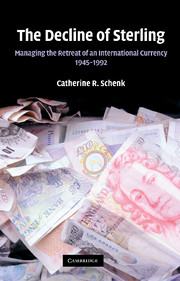Book contents
- Frontmatter
- Contents
- List of figures
- List of tables
- Acknowledgements
- 1 Introduction
- Part I Reconstructing the International Monetary System 1945–1959
- Part II Accelerating the Retreat: Sterling in the 1960s
- Part III Sterling's Final Retreat 1970–1992
- 9 Sterling and the end of Bretton Woods
- 10 Years of crisis 1973–1979
- 11 The aftermath 1980–1992
- 12 Summary and overview
- Index
12 - Summary and overview
Published online by Cambridge University Press: 04 May 2010
- Frontmatter
- Contents
- List of figures
- List of tables
- Acknowledgements
- 1 Introduction
- Part I Reconstructing the International Monetary System 1945–1959
- Part II Accelerating the Retreat: Sterling in the 1960s
- Part III Sterling's Final Retreat 1970–1992
- 9 Sterling and the end of Bretton Woods
- 10 Years of crisis 1973–1979
- 11 The aftermath 1980–1992
- 12 Summary and overview
- Index
Summary
The operation of the global economy still relies on a set of international currencies that are accepted as unit of account, means of exchange and store of value for a range of government and private purposes. The volume of foreign exchange reserves to world trade has decreased since the pegged exchange rate system was abandoned, which reduced the need for precautionary reserves. Innovation in reserve management with greater use of market resources has also reduced the need for central monetary institutions to hold owned reserves. Nevertheless, accumulations of large foreign exchange reserves by emerging economies such as China and Russia in the 2000s have to some extent reversed this trend. This has renewed questions about the costs and benefits of issuing an international currency, particularly in the context of the benign neglect of the United States towards its exchange rate and the growing global imbalance during the 2000s. The rise of the euro as a challenger to the US dollar has further increased interest in how international currencies emerge and how they can be replaced without disrupting the global economic system. The case of sterling in the post-war decades provides an opportunity to examine this process.
The case is particularly interesting because, like the dollar, the demise of sterling as a reserve and international transactions currency was widely predicted, although the process was slower than anticipated. Was this due to British government efforts to prolong sterling's role because it increased the capacity to borrow, because it enhanced Britain's international prestige or because it supported London as a centre for lucrative international finance?
- Type
- Chapter
- Information
- The Decline of SterlingManaging the Retreat of an International Currency, 1945–1992, pp. 414 - 430Publisher: Cambridge University PressPrint publication year: 2010



